Interviews with experts and opinion leaders from our research network
On the occasion of the 50th anniversary of the establishment of Hitachi Research Institute (HRI), we invited Professor Emeritus Ikujiro Nonaka, Hitotsubashi University to talk about the approach to become a self-transforming organization that creates new value. Professor Nonaka is an expert in management studies who has written many well-known books, including the bestseller Essence of Failure and The Knowledge-Creating Company, which theorized the process of organizational innovation. Looking into management theories such as the SECI model proposed by Professor Nonaka and Hitachi's management vision and business strategies, we will discuss how to carry out knowledge creation and what should be done to survive global competition. (Interviewer: Norihiro Suzuki, Chairman of Hitachi Research Institute)
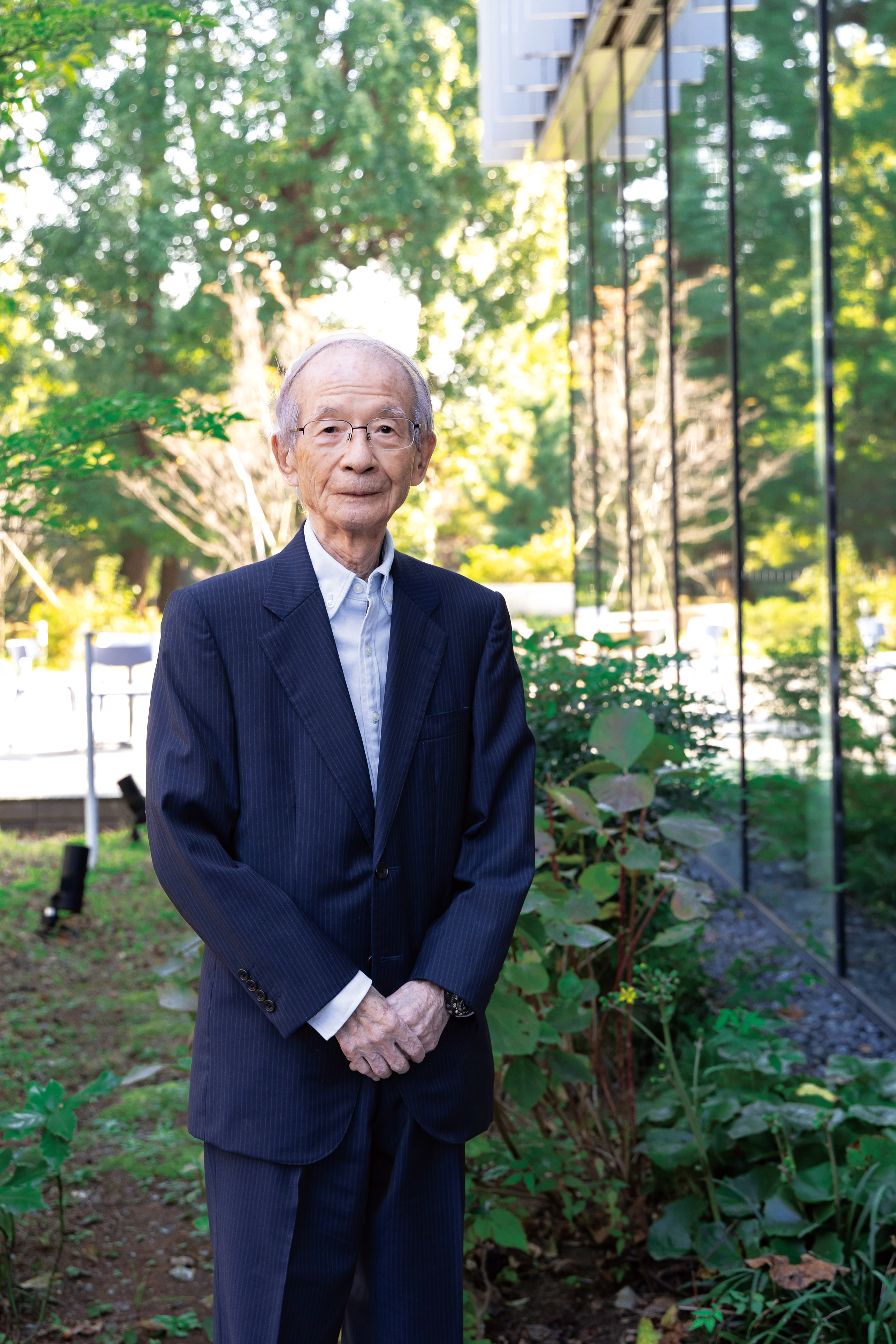
Professor Emeritus, Hitotsubashi University
Born in Tokyo in 1935. He received his B.S.(Political Science) from Waseda University in 1958. After working at Fuji Electric Co., Ltd, he received his PhD(Business Administration) from the University of California, Berkeley. He served as Professor in the Department of Business Administration, at Nanzan University, at the National Defense Academy, as Professor and Director at the Institute of Business Research, Hitotsubashi University, as Dean and Professor at the Japan Advanced Institute of Science and Technology, and as Xerox Distinguished Faculty Scholar at University of California, Berkeley. He is currently Professor Emeritus at Hitotsubashi University and a member of The Japan Academy.
As an authority on knowledge management who popularized the theory of organizational knowledge creation around the world, he has given numerous lectures both in Japan and abroad. In 2013, he was named one of the ten leading Business School Theorists in The Oxford Handbook of Management Theorists. His major works include Organization and Market: A Contingency Theory (Chikura Shobo), Essence of Failure: Organizational Study of the Japanese Armed Forces during the World War II (co-author, Diamond-sha), Management by Eidetic Intuition: A Dynamic Management Theory Predicated on the “Philosophy of Empathy” (co-author, Palgrave Macmillan), The Knowledge-Creating Company: How Japanese Companies Create the Dynamics of Innovation (co-author, Oxford University Press), The Wise Company: How companies Create Continuous Innovation (co-author, Oxford University Press), and Management by Wildness Spirit (co-author, KADOKAWA).
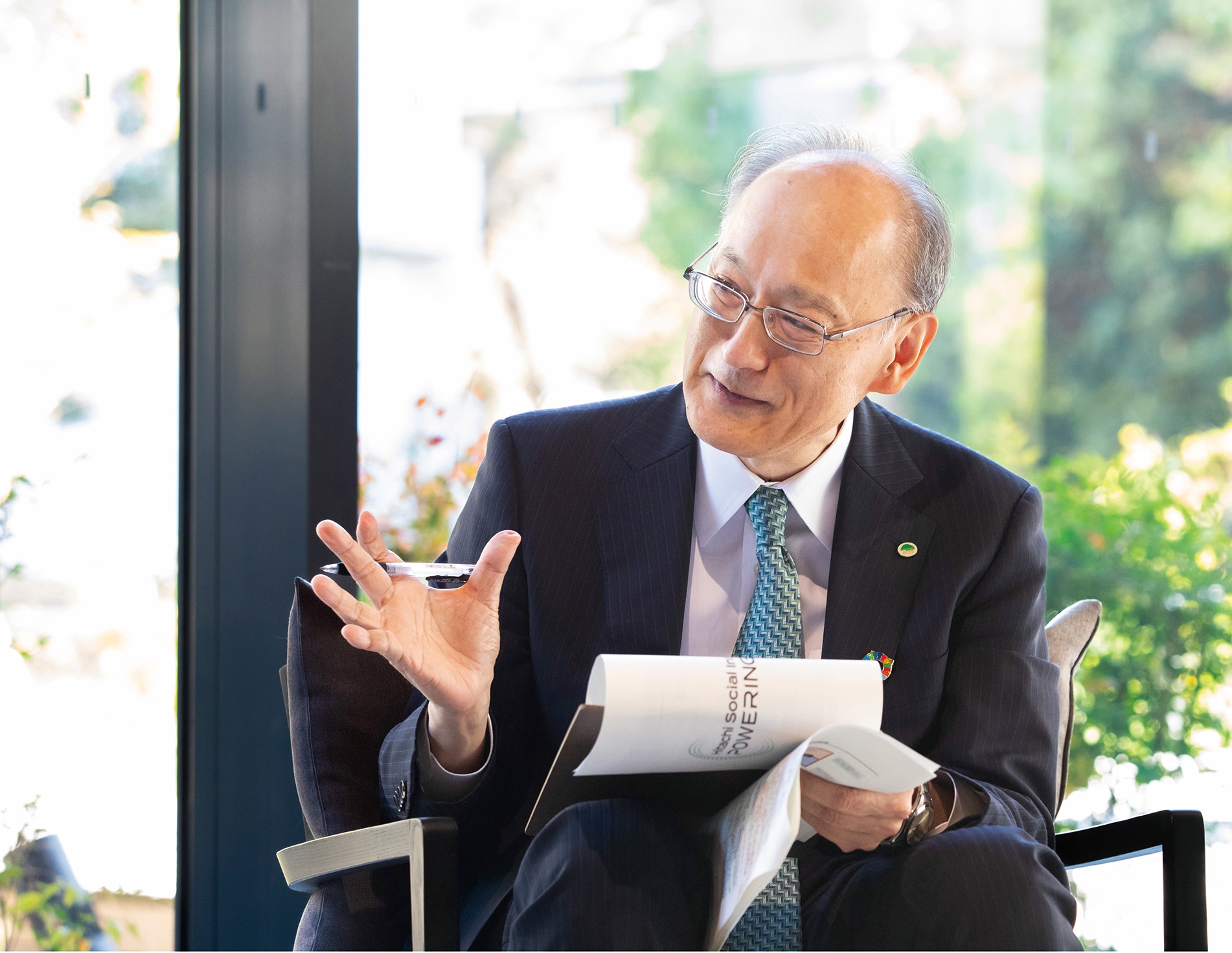
Suzuki:Hitachi has defined the Social Innovation Business as its single purpose and is aiming to realize a sustainable society through data and technology. In other words, we aim not only to pursue economic value such as sales and profits as a company, but also to create environmental and social values by solving problems related to planetary boundaries and improving people's well-being through social innovation business. I believe that Hitachi's purpose has something in common with the “dynamic duality” that you advocate. Please tell us why purpose is important for companies now, and what is necessary for Hitachi to realize the dynamic duality of pursuing economic value as well as environmental and social value.
Nonaka:First of all, “dynamic duality” can be said to be about discovering new horizons with a leap of imagination by taking the advantage of characteristics of two different extremes of seemingly contradictory things, depending on the context and purpose. Every day, we face a lot of dilemmas and are forced to make choices, and we often act without thinking deeply and choose the easier option based on whether the majority does it or not, without fully considering the meaning of each option. If we continue to make the easier choice, we will not find another innovative way forward.
On the other hand, if we consider each option thoroughly, and see how different or similar the two options are from each other, then it is more likely that a new path will emerge – one that is different from both options. In other words, this is not a dichotomy in which things and problems are perceived as “either A or B,” but a “dynamic duality” of “both A and B,” in which judgment and action are made flexibly and dynamically about what to do according to the situation. Dynamic duality is the process of innovation that creates new meaning and value by, thoroughly, confronting the difference and commonality of two things that seem to contradict each other.
Suzuki:Why is purpose important in achieving dynamic duality?
Nonaka:Purpose does not show “what” the company is about, but about “why” it exists. The question of “why” can be pursued and spiraled up infinitely, so the more you delve into it, the more you forage into the question of existence itself. In other words, because purpose has a dynamic nature of continually asking ourselves “why,” it becomes a driving force for further evolution and self-transformation in an ever-changing reality.
It would be important for Hitachi to continue self-transformation while constantly asking the question “why,” and to dynamically co-create economic value with environmental and social value. Let me take the example of Eisai Co., Ltd., which has embraced a “dynamic duality” management policy of pursuing both its social value and shareholder value. In 1992, Eisai established the groundbreaking corporate concept of “human health care (hhc).” In 2005, it added in its Articles of Incorporation that “The Company’s mission is the enhancement of patient satisfaction. The Company believes that revenues and earnings will be generated as a consequence of the fulfillment of the mission. The Company places importance on this positive sequence of the mission and the ensuing results.” What is important here is that it clearly states that the mission comes first, and the benefits come as a result of fulfilling that mission. Furthermore, in 2022, Eisai has declared that it would expand the role of hhc to “patients and consumers” and “strive to evolve into a company that supports people’s entire lives by achieving social good.” Eisai has thus continued to transform itself, even changing its Articles of Incorporation twice through the general meeting of shareholders.
Suzuki:Indeed, continuing to question its purpose has become the driving force behind its corporate transformation.
Suzuki:I think that the SECI model will play an important role in continuously transforming ourselves by constantly questioning the meaning of our existence and achieving both economic value and environmental and social value. Can you tell us more about the SECI model?
Nonaka:The SECI is a model of the process that starts with (1) “S” for “Socialization,” in which individuals share tacit knowledge with each other, followed by (2) “E” for “Externalization,” in which tacit knowledge is transformed into explicit knowledge at the group level, then (3) “C” for “Combination,” in which explicit knowledge is combined at the organizational level to transform it into collective knowledge that can be shared socially and systematically, and (4) “I” for “Internalization,” in which each individual enriches tacit knowledge by practicing this collective knowledge. The point here is that the SECI is not a model of knowledge creation at the individual level. It is a theory that explains the process of organizational innovation and collective creation of new meanings and values. It also explains the principle of transforming the tacit knowledge of individuals into collective wisdom. This is rooted in a view of human beings as dynamic entities who create meaning and value in their future-oriented relationships. The idea is that we can make the most of tacit knowledge, which represents the potential of each individual, including the unconscious, and bring them together through interaction with others.
As Michael Polanyi, a philosopher of science, said, “All knowledge is either tacit or rooted in tacit knowledge,”*1the source of all knowledge is tacit knowledge, and “We can know more than we can tell.”*2 Tacit knowledge is “knowledge” that moves in the context of the now and here, and is subjective, at the same time bodily, emotional, and artistic. What is important here is that tacit knowledge and explicit knowledge are connected and do not exist separately. In other words, explicit knowledge cannot be created without tacit knowledge, and If we use the iceberg model to illustrate the relationship between tacit and explicit knowledge, the quantity and quality of tacit knowledge below the surface of the water determines the quantity and quality of explicit knowledge above the surface.
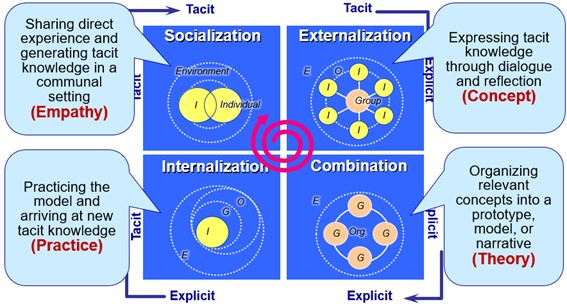
Source: Nonaka Laboratory
Suzuki:I feel that the SECI model and the framework of Hitachi's Lumada*3 have something in common. Through Lumada, we aim to create a sustainable value creation cycle by first understanding customer issues, then creating and implementing solutions using Hitachi's IT, OT, and products, and then working on the next issues while conducting operation and maintenance. The most important part of this cycle is the process of discussing issues with customers and seeking solutions with them. “Kyoso no Mori” was established in the Hitachi Central Research Laboratory (Kokubunji City, Tokyo) as a venue for this process. This place can be referred to as a “Ba” for socialization, which is the starting point of the SECI model.
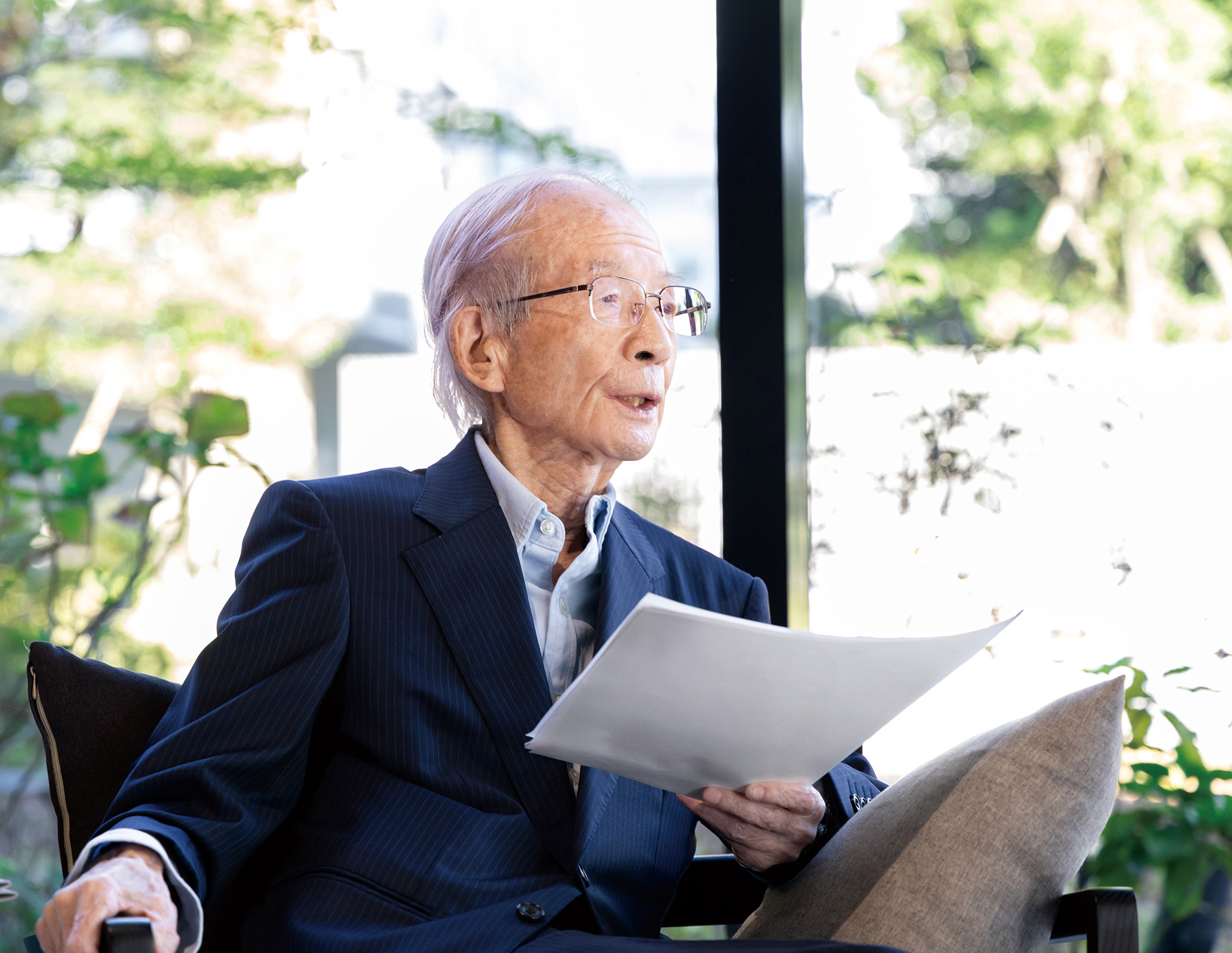
Nonaka:In the SECI model, it is important to infinitely spiral up the process of mutual transformation between tacit knowledge and explicit knowledge, and the starting point of this process is the Socialization. In Socialization, through face-to-face interaction, we use our five senses to empathize with others, things, and the environment with our whole body and soul, and share as a group to the very root of tacit knowledge. Externalization is also a process in which people engage in intellectual combat and, through dialog, thoroughly verbalize tacit knowledge, including the alaya-vijnana*4 or the unconscious. In this sense, Hitachi's Lumada is remarkable for its exquisite integration of the analog and the digital. As a use case of Lumada, when I conducted the interview and heard about the introduction of an “automatic planning system for optimal production and manpower allocation” at Nichirei Foods Inc.,*5 I felt that it is closely related with the SECI because you did not start with planning and analysis, and I thought it is an excellent approach.
Suzuki:What are the key points in practicing the socialization?
Nonaka:As the Japanese sayings “a-un-no-kokyu” (close synchronization of breathing and feeling, or harmonious relationship without verbal communication) and “sottaku-doji” (perfect harmony between learner and master), the ability to share tacit knowledge through empathy and dialog is greater among Japanese than among Westerners. On the other hand, as I pointed out in Essence of Failure, it is essential for individuals with different subjectivities to engage in intellectual combat with their whole body and soul in order to avoid over-reading the room and stopping thinking. German philosopher Edmund Husserl explained that interacting with others through empathy, or creating “intersubjectivity,” is the foundation for creating objective knowledge that can be shared in society and organizations. New meanings and values can emerge by transcending the ego and becoming completely absorbed with the other person to reach a state where we can say “this is it.” Therefore, instead of just brainstorming, we need to engage, thoroughly, in open-hearted and frank dialog in an unconventional setting, transcending boundaries, titles, and time limits. In other words, it is necessary to engage in "intellectual combat" without compromising or guessing too much about what one is implying. It is only when we overcome such a struggle that strong empathy is born.
Some innovative companies have “Ba” or organizational routines for activating intellectual combat, which are effective for Socialization and Externalization. IRIS OHYAMA Inc., which creates more than 1,000 new products annually, holds a New Product Development Meeting every Monday, where top management and project members from all product development departments gather to discuss and make agile decisions on product concepts, prices, and feasibility. Seven & i Holdings Co., Ltd.’s “Team MD (Merchandising)” product development method and Honda Motor Co., Ltd.’s “Waigaya” culture are also well-known examples of these initiatives. The President and CEO of Honda, Toshihiro Mibe said that the essence of Waigaya is not only to engage in open dialog, but also to “write things down” was striking. In Waigaya, project members record each member’s comments on a whiteboard or large sheets of paper while engaging in lively discussions, and new concepts emerge as they review the words they have written. In this regard, a linguist Toshihiko Izutsu pointed out that the act of “writing” is not just a recording of facts, but a manifestation of the meaning of life, i.e., it is an act of knowing the meaning of the “word,” which is its power, enriching one's tacit knowledge, and creating a new world. That’s why I think verbalization is very important.
Suzuki:It is indeed crucial to make platforms so called “Ba” and routines for intellectual combat and to carry out verbalization. When I was stationed in the U.S., I had the opportunity to visit the research laboratories of some advanced companies. They did not only have a place to discuss with customers, but also a lodging facility, so we could have discussions while having dinner, too. They practiced the process of visualizing, verbalizing, and conceptualizing after engaging in intellectual combat. I was reminded of the importance of feeling with the five senses when we were prevented from having direct dialog with others during the COVID-19 pandemic. Now that the pandemic is behind us, I have reaffirmed the significance of Kyoso no Mori as a “Ba” for intellectual combat.
Suzuki:It is said that Generative AI has the potential to significantly change human intellectual production activities. The way of knowledge creation will be changed with Generative AI, but what do you think will be changed or will not with Generative AI?
Nonaka:This is a difficult question, but no matter how much AI technology advances, the essence of knowledge creation, in which tacit knowledge is the source of new knowledge, will not change.
On the other hand, there is no doubt that digital technology and AI will serve as an effective support tool for innovation that creates new value. Making full use of Generative AI will help to connect and theorize explicit knowledge, support intellectual combat, and contribute greatly to knowledge expansion and creation. However, I feel that knowledge management, which many companies had been engaged in before, has been too focused on sharing explicit knowledge, such as information sharing and management using IT tools. Even though the source of knowledge is tacit knowledge, I think enriching tacit knowledge itself had not been pursued as enthusiastically as it should have been.
Empathy and intuition, which are the starting points of knowledge creation, should be felt through the full use of the five senses in the entire human body. AI, on the other hand, which has no body, cannot have empathy. Therefore, it is difficult for AI to gain insight into the meaning and essence behind reality through empathy in direct experience, to draw out the unconscious awareness at the deepest level of tacit knowledge, and to create new meanings by freely combining all kinds of knowledge including the unconscious. Although some phases of the SECI model can be supported and replaced by digital technology and AI, the Socialization, which are the starting points, cannot be replaced by AI at least not now. Moreover, in terms of Externalization, where we transform tacit knowledge into explicit knowledge such as concepts, tacit knowledge generated in direct experience is qualitatively and quantitatively important as the source of explicit knowledge. Thus, it is difficult to create new concepts without the involvement of an intrinsic intuition that is linked to corporeality.
Suzuki:Generative AI is based on past data and knowledge, so it has no knowledge or wisdom about what will happen in the future. After all, creating value, as you said, must begin with experience, i.e., feeling and empathizing directly firsthand. I agree that it is important for us as humans to engage in value creation through intellectual combat while leveraging Generative AI.
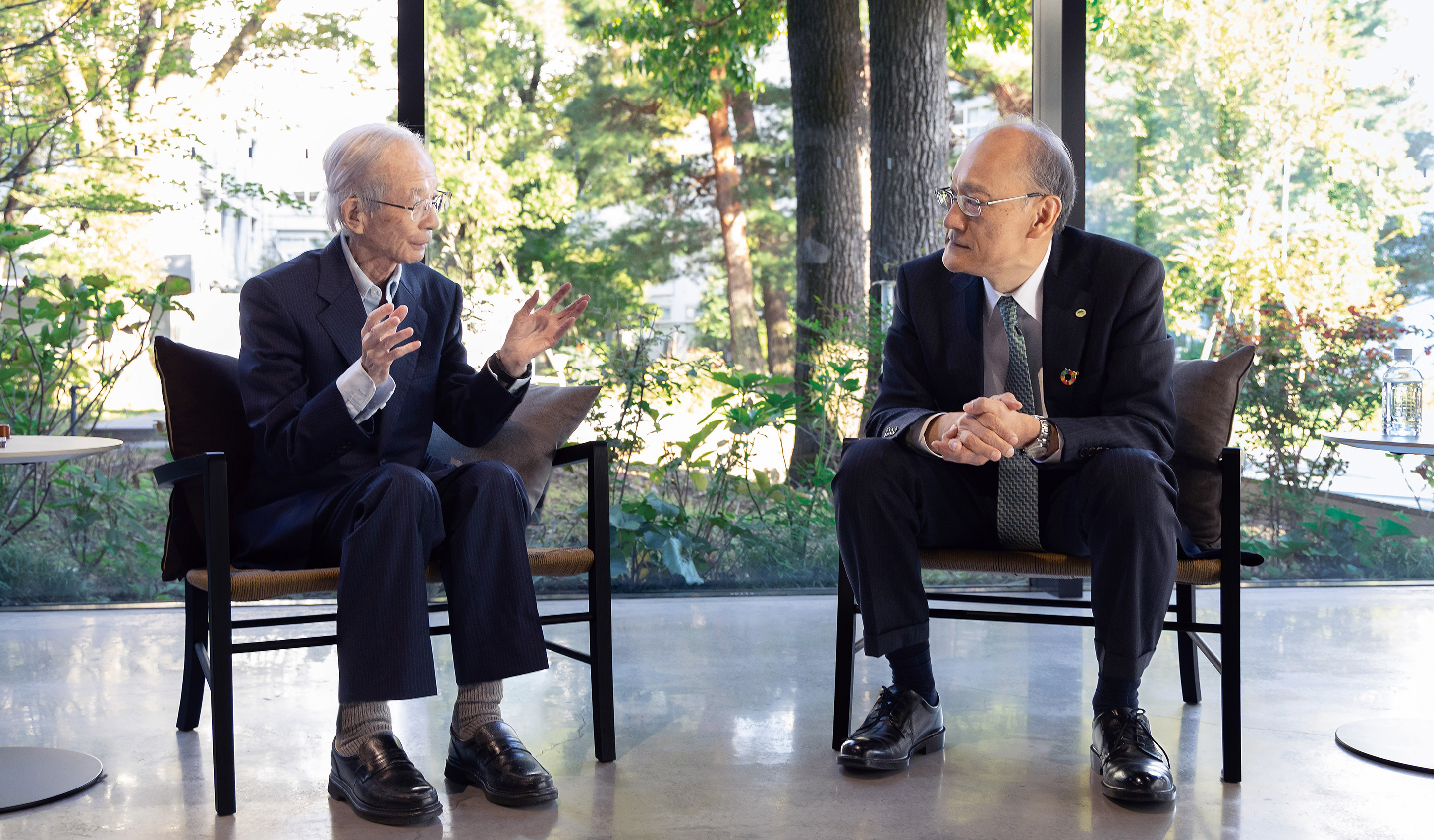
Suzuki:In order to create new value, I think it is very important to have talents, leaders, who will be responsible to carry it out. In June 2023, when I had a conversation with Mr. Takashi Kawamura, Chairman Emeritus of Hitachi, Ltd., we had a very lively discussion on “fostering and educating leaders with animal spirit.”*6 With environmental and other global issues and geopolitical confrontations becoming extremely intense, it is crucial for any company to train leaders who are up to the task of tackling these issues. As you are researching the ideal form of leadership in various organizations from companies to the military, please tell us about your thoughts on the mindset and qualities required of global leaders.
Nonaka:Recently, I have been advocating the concept of “Humanizing Strategy.” This concept is a wake-up call to Japanese organizations that have become overly logical in their approach by engaging in over-planning, over-analysis, and over-compliance. In a closed and fixed organization, the “wildness” that is the source of creativity, deteriorates, and innovation cannot occur. I point out the necessity of the humanized strategy, which unleashes and refines wildness in order to bring management and strategy back to people, since management is nothing but a human activity. When the philosopher Husserl, who advocated intersubjectivity, asked why the World War I occurred without justice, he critically pointed to the tide of modernity and said that the root of the problem lay in the mathematization of everyday life. The conflict between the overemphasis on science and humanity may be an eternal challenge for human beings, but in order not to become a slave to numbers and data, we need to demonstrate the wildness, which gives us the ability to survive as human beings and to grasp directly the meaning behind the numbers in the midst of the moving context of reality.
One of the virtues advocated by the ancient Greek philosopher Aristotle, “phronesis” (practical wisdom), is also very important as a quality required for leaders. In a dynamic and ever-changing reality, the essence of leadership is to have the practical wisdom to make better insights and judgments as needed and to act in a timely manner toward the common good for the future.
Suzuki:What should companies do to develop such leaders?
Nonaka:The accumulation of experiences that are diverse in terms of both quantity and quality develops the ability to enrich the tacit knowledge, which is the basis of insight and intuition as a leader. For this reason, it is important for leaders to have the opportunity to have challenging experiences and co-work with diverse people.
Sony’s former CEO Kazuo Hirai, who led the turnaround of the Sony Group, introduced the concept of “Kando” and made it a banner for the revitalization of the company. At that time, he read Sony's establishment prospectus many times, and in his repeated dialogs with front-line employees, he heard the word “Kando,” which he then elevated as Sony's purpose. He had visited branches and offices around the world and held more than 70 town hall meetings to interact with employees. This is also the case with Mr. Mibe of Honda, who advocates the departure from conventional engines, and also with Hitachi’s past CEOs, Mr. Takashi Kawamura, Mr. Hiroaki Nakanishi, Mr. Toshiaki Higashihara and current CEO, Dr. Keiji Kojima, who had led the Hitachi's revitalization. They have become practical wisdom leaders through their diverse and tough experiences. That is why they can continue to take on the challenge of revitalizing the giant ship, Hitachi, with ideas that are not bound by precedents and without overly adapting to the past success.
To develop leaders, it is important to aim for a flexible, organic, autonomous, and decentralized organization, rather than a top-down, rigid, and mechanical one. We named the development style of the Japanese manufacturing industry in the 1980s as “Scrum” and analyzed its innovative approaches. This model was later applied to agile software development by Dr. Jeff Sutherland and others. When I met him, he said, “Practicing Scrum is a way of life.” He said that in order to truly master Agile Scrum, it is important to actually try it until the body learns it, as in “Shu-ha-ri.”*7 He also said that self-transformation can be achieved through Shu-ha-ri, and that everyone has the potential to become an exceptional individual. The current decline in the competitiveness of Japanese companies is a result of the loss of wildness due to the rigidity, over-planning, over-analysis, and over-compliance. It is important to “feel before thinking” with the embodied knowledge that we inherently possess.
Suzuki:You mean to say that you cannot be a global leader unless you have practical wisdom and wildness, right?
Nonaka:Yes, after all, leaders need to tell exciting narratives before they talk about numbers. This is because it is not the logical or scientific explanations that move people, but the narrative that appeals to human subjectivity and promotes behavioral change. Even if you understand in your head, if your heart does not move, your body won’t move.
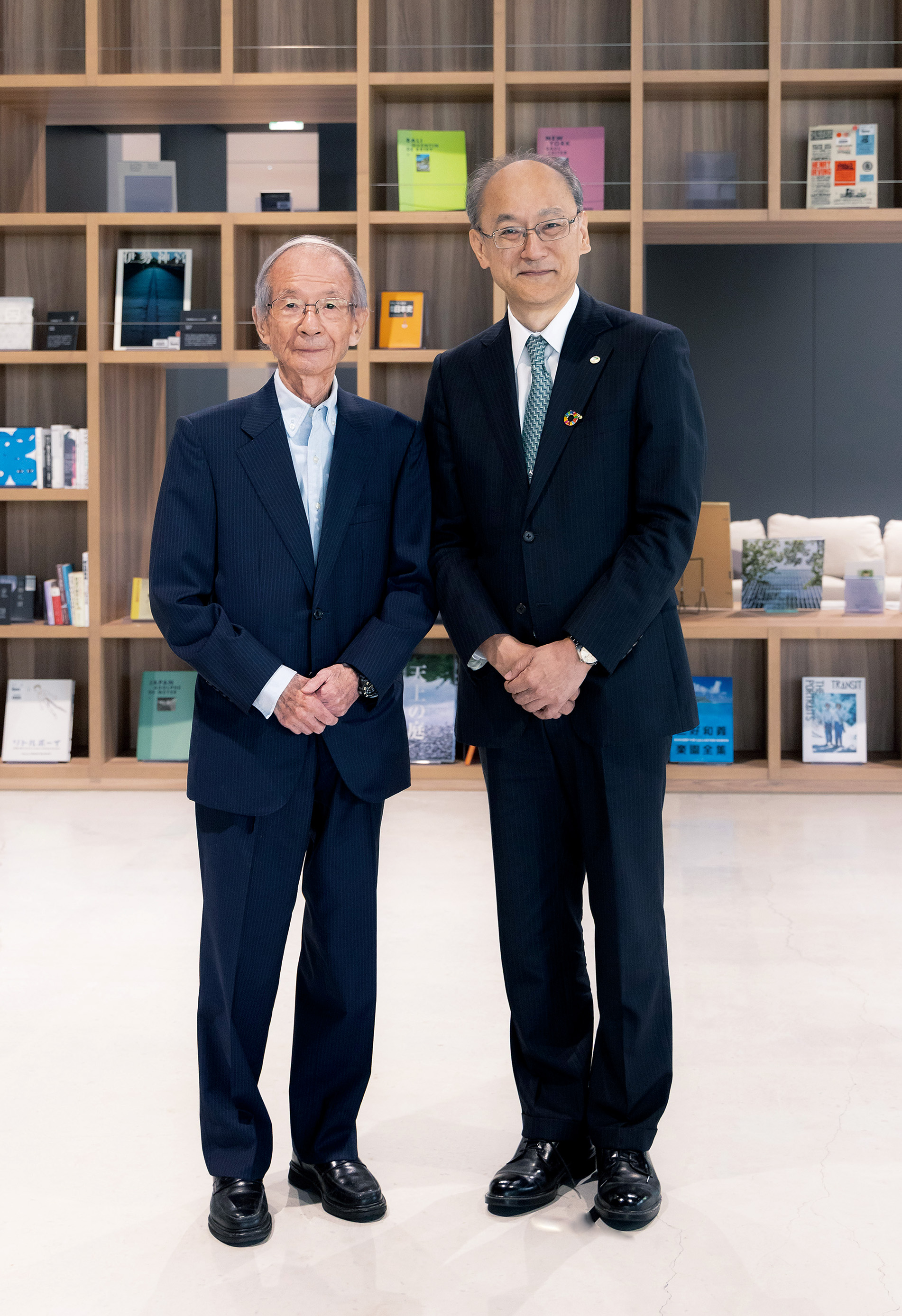
Suzuki:As the global situation and business environment become increasingly uncertain, what will be important for Hitachi and HRI to continue creating new values?
Nonaka:When I had taught at the National Defense Academy for about three years from 1979, I conducted the research project on military history and summarized the results of our research in Essence of Failure. Our research on the cause of the defeat of the Imperial Japanese army in the World War Ⅱ led us to conclude that it was because of a lack of capability for self-transformation. The United States Marine Corps, USMC, on the other hand, adopted and improved the innovative concept of “amphibious operations” during the Pacific War. Since its establishment, the Marine Corps has been continually questioned about its “raison d'etre” as an organization, being caught among the Army, Navy, and Air Force. They constantly questioned their values, such as "Why do we exist?" and created the concept of “from the sea,” an “amphibious” strategy to command the sea and land in a dynamic duality. Since then, the Marine Corps has transformed itself through the creation of the new concepts, such as “emergency deployment units” and “expeditionary response units.” In 2020, under the leadership of the Commandant General David H. Berger, the Marine Corps announced “Force Design 2030,” which proposed drastically reducing ground forces and repositioning them to support naval operations. As such, it has constantly transformed itself in step with the times.
I once asked a high-ranking officer stationed in Japan why the Marine Corps continues to be an organization that never stops changing. He said, “We always ask the question “why,” i.e., “Why do we exist?” the Marine Corps is not a well-budgeted organization, but it doesn’t cost money to think.” I was very impressed with that answer. Thus, I believe that continuing to proactively question the meaning and purpose of a way of life leads to the creation of new values that transcend dichotomy.
To create new value, it is also imperative to encourage trial and error, challenges and tolerate failure. Professor Paul Iske of Maastricht University in the Netherlands recognized failure as an important learning opportunity and founded the Institute for Brilliant Failures within the university. Initiatives like this will become important in an era where quantitative management may be said to have been dominant. In Hitachi's Lumada, not only success stories, but also initiatives and “Ba” to learn from failures will become increasingly important. Lumada is a very ambitious initiative because you are trying to co-create not only within the company but also across industries and verticals with your partners. In this respect, it is significant that Hitachi has created and disseminated this new concept, Lumada. This is one of the manifestations of self-transformation. I hope you will do your best as one of the companies responsible for the future of Japan.
Suzuki:We have actually established the Lumada Data Science Lab within the Central Research Laboratory to serve as the core organization in the AI and analytics fields by gathering Hitachi's specialized knowledge, know-how, human resources, and cutting-edge technologies from a wide range of industries and businesses. This is exactly how we use “Ba” for co-creation to engage in direct dialogs with companies from different industries, and work together with customers, business divisions, and researchers to solve problems that are difficult to solve.
Nonaka:In order to activate the innovation process as an organization, it is necessary to ask what kind of “knowledge ecosystem” your company currently has and what you want to do in the future. An R&D department can be considered as a crystallization of “knowledge maneuverability”*8 that brings together top professionals and puts knowledge into practice. The essence of strategy depends on how you can create new knowledge. Therefore, as an R&D department, I would like to see you thoroughly engage in direct dialog across industries, while valuing the tacit knowledge acquired through emotion and the five senses.
Suzuki:Going forward, we, HRI, will endeavor to emphasize the importance of experiencing firsthand the issues facing our customers and society. Thank you for taking time out of your busy schedule today to share with us your valuable and thought-provoking insights.
References
Ikujiro Nonaka, Mikiharu Noma, and Yumiko Kawada, 2023, Special Contribution “Dynamically Dual Management” Practice, Hitotsubashi Business Review 2023 SPR
Ikujiro Nonaka and Jeff Sutherland, 2020, Thinking of Development and Management from Agile/Scrum, Administration & Information Systems, April 2020
https://www.iais.or.jp/articles/articlesa/20200410/202004_01/
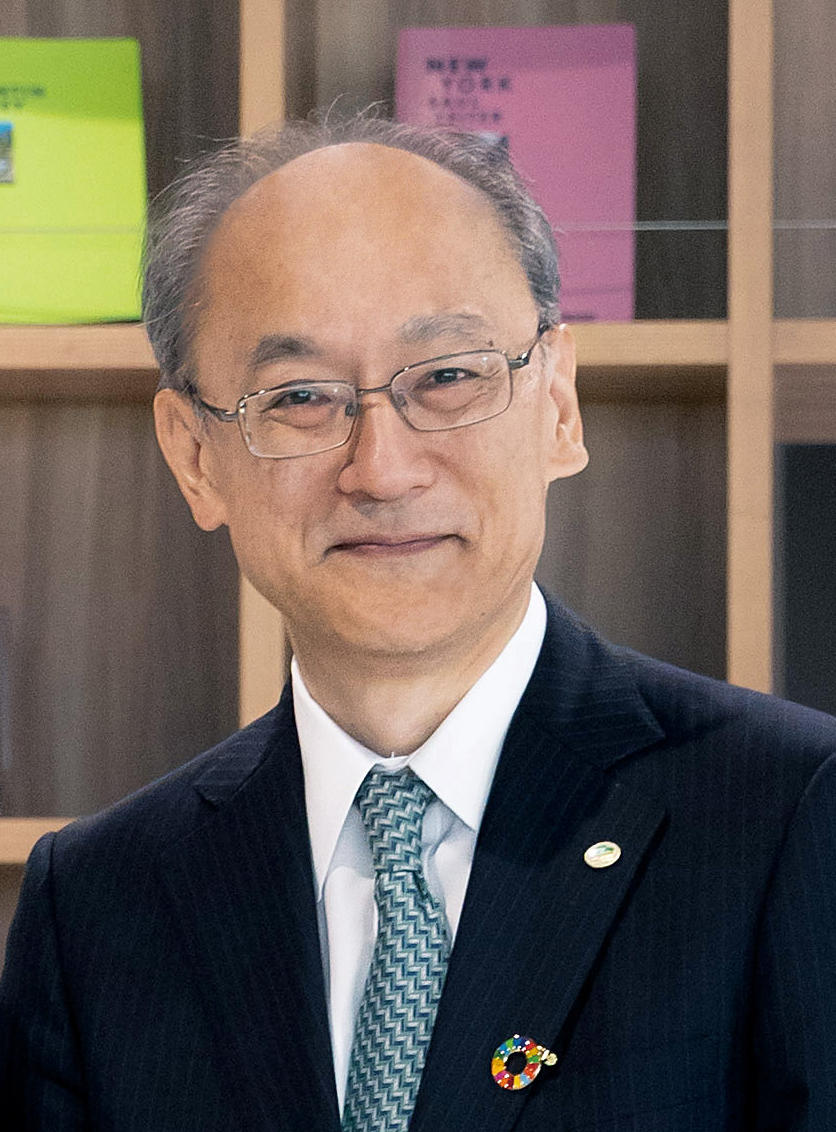
Professor Nonaka's words on dynamic duality that “the more dissimilar two things are, the more we can see new paths that are different from either of them” are a great encouragement for Hitachi, which is promoting Social Innovation Business. In addition, through his insights on knowledge-creating companies, we have reaffirmed the importance of the process of thoroughly verbalizing the tacit knowledge that lies in individuals through dialog, so HRI will keep trying to create new values based on empathy through intellectual combat with face-to-face discussions. We will endeavor to constantly question the meaning of our existence and achieve self-transformation while experiencing global trends firsthand.
Norihiro Suzuki, Chairman, Hitachi Research Institute